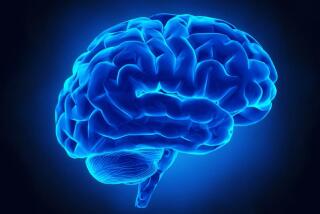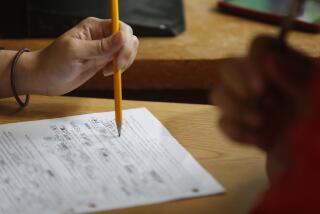Remember This: Scientists Discover How It’s Done
- Share via
WASHINGTON — Scientists for the first time have used sophisticated imaging techniques to watch people’s brains at the split second they create a memory, showing which parts of the brain determine whether a specific experience will be remembered or forgotten.
The findings “mark a significant step forward,” said memory expert Michael D. Rugg of Britain’s University of St. Andrews, who critiqued the unique pair of studies by scientists at Harvard and Stanford universities in today’s edition of the journal Science.
Because one of these memory-making regions is ravaged by Alzheimer’s disease, the scientists now are studying whether their findings also could help detect the devastating brain disease in its earliest stages.
“We’re really excited about the prospect of this being used for Alzheimer’s disease,” said Stanford neuroscientist James Brewer, who led the memory study and was preparing to scan the brain of an Alzheimer’s patient Thursday. “If we were able to detect Alzheimer’s really early, the prospect for treatment is much, much better.”
Scientists have long suspected that how well people remember depends on differences in how their experiences are “encoded” into the brain at the time they occur. Studies of people with brain damage have suggested various brain regions were involved, but it wasn’t clear if damage to those regions meant people couldn’t make new memories, retrieve old ones or store memories over time.
New, high-powered magnetic resonance imaging, or MRI, machines work fast enough that scientists can measure split-second neural activity as a person’s brain processes an experience.
At Harvard, neuroscientist Anthony Wagner put healthy volunteers into these “functional MRI” machines and rapidly flashed one word every two seconds onto a screen inside. At first, the volunteers merely noted whether words were in uppercase or lowercase letters. With additional words, they were told to decide if each was concrete, like “chair” or “book,” or abstract, like “love” or “democracy.”
That’s because psychologists already knew that analyzing the meaning of a word helps people remember it.
In Stanford’s study, Brewer showed volunteers color photographs of indoor and outdoor scenes rather than words.
Neither set of volunteers had been told this was a memory test. But after the MRI scans, they were asked which words or pictures they remembered well, remembered vaguely or didn’t remember. The scientists compared those memories to the brain scans.
The longer that two brain regions--the prefrontal lobes and the parahippocampal cortex--both lit up on the MRI scans, the better people remembered the items. Words or pictures that caused weak activity in the two regions were forgotten.
What makes your brain more likely to react to one item over another? “That’s the million-dollar question,” Wagner said.
The studies provided some hints. Wagner’s volunteers showed more neural activity and better memory during the “concrete-abstract” word test than for other words, providing biological evidence that more complex cognition increases the chances of memory.
And personal experiences probably play a role. Perhaps Brewer flashes a photo of Zion National Park. Someone who just visited there may react more than someone who says, “Oh, a desert scene.”





